What are OKR Levels?
One of the most important decisions to make while launching your OKR program is to decide specifically at what level you choose to set your OKRs. There are four levels at which OKRs can be set:
Setting OKRs at a combination of these four levels will help you align and focus your team’s energy on your top-priority goals, yielding high-quality results faster. In this article, we’ll walk through the types of OKRs you’ll find at each of these four levels, the best practices for setting OKRs, as well as the array of different approaches you can use when setting your OKRs at multiple levels. Let’s get started!
Company Level OKRs
The most commonly-used level in organizations across industries is the company level. Company OKRs, also called corporate OKRs, reflect the high-priority goals that business leaders have selected to further the long-term strategy and achieve the company’s vision and mission.
So let’s say, at the company level, you have an OKR to help you grow your business. Let’s call the objective “Grow revenue.” Fast forward a quarter or a year, how will you know that you have grown the revenue?. To help track progress, we’ll create key results which will answer that question precisely. All key results should be projects, initiatives, or targets that will necessarily increase revenue in the organization. One of the key results can be “Increase Account Renewals from 60% to 90%”.
A second key result may be to launch some new products. You can launch a couple of new products in the areas where your competition is stronger than you. You can add the key result “Launch a new product”.
A third key result that may be focused on entering some new geographies. You could have the key result phrased differently. For example, “Expand the number of countries in which we operate from 10 to 15 countries.” The company-level OKR would look like this: he company-level OKR would look like this:
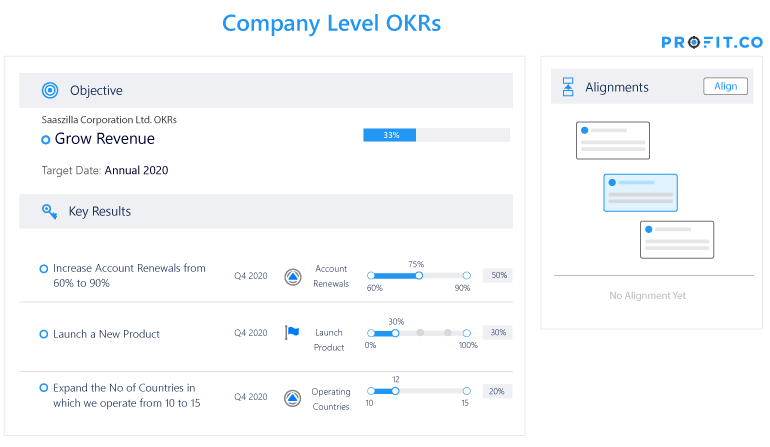
The key results from this corporate OKR will be cascaded down the organization to become department-level OKRs. This is a form of top-down alignment that enables departments to focus time, effort, and resources on the goals that matter most for the company. Typically, the company level will have three or four company OKRs. The next level is the department level.
Department Level OKRs
Department-level OKRs are the responsibility of the entire department as a whole. These are usually cascaded down from the company-level, as we saw in the previous example, or they are written to reflect the most important and urgent projects and goals of the department itself.
Let’s continue with the example we saw last. In order to truly grow revenue, the company’s marketing and sales departments need to be heavily involved in the completion of the example OKR.
Marketing has to generate new revenue opportunities, maybe identify new markets to enter. Then, the sales team obviously has to nurture the leads from marketing and then go and execute on the sales process to get you this growth. The research and development team, obviously, will have to work on those new products, as well as improve existing products, so their products fare well in the market. And the manufacturing and other services teams may have to either create additional capacity or introduce new manufacturing lines or manufacturing plants to support these growth goals. These “things to do” that originated from the corporate OKR will essentially become the department OKRs.
So, let’s take the marketing team. Now, one of the key results at the corporate level was to increase the number of countries you operate from 10 to 15. The marketing team can say, one of their objectives is to “Penetrate Italian market.”
Now, that objective will be measured by a few key results. One of the key results might be to open a sales office, and assuming you decide on the location to be Milan, the key result will be, “Open a sales office in Milan by March of this year,” or, “End of Q1 of this year,” which will give you essentially about three more quarters (Q2, Q3, Q4) to ramp up and execute well in the Italian market. The second key result could be to hire a VP of sales for Italy, based out of Milan. This may have to be done in an earlier time frame than the end of Q1, but can be defined as a Q1 key result.
Once you have the location setup and a head hired, you can have a couple of key results to test the waters a bit. So, the third key result for this quarter can be to generate 30+ leads for Italy. And finally, a 4th key result could be to have at least 3 reference customers from Italy. Now, with this setup, you can aggressively execute for the next three quarters. You’ll have a local office, local leader, you would’ve demonstrated the ability to generate leads and finally, you’ll have customers that can be quoted as happy references for newer prospects.
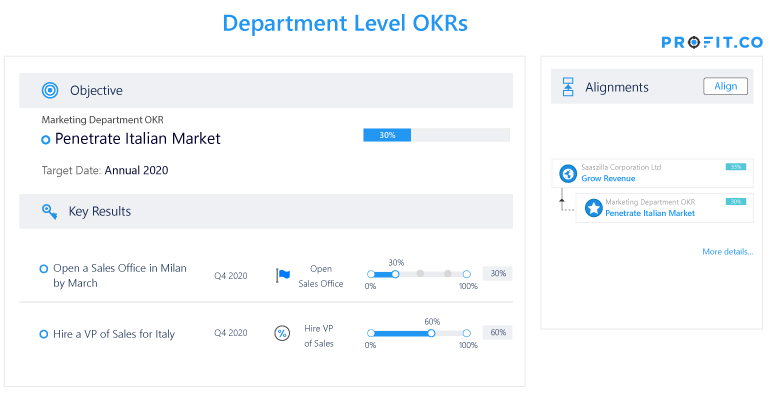
So, this is a department OKR of the marketing department, which essentially would align with the corporate OKR, “Grow revenue.” And specifically, it would tie back to the key result to enter new geographies or increase the number of countries that we operate in from 10 to 15.
Many organizations choose to only use the company level and department levels in their OKR implementation, limiting the amount of alignments they have to make and keeping the view of the company’s most important goals clear and uncomplicated.
With this set up, the organization essentially has the corporate OKR, the department OKRs, and then they assign the individual key results of these OKRs to other individual people within the department. The key result to open a sales office in Milan could be assigned to a particular director. Hiring a VP of sales could obviously be assigned to HR or a HR Rep, who’s not necessarily in the department, but maybe the HR department actually can create their own OKRs, which will align in turn to penetrate this particular Italian market OKR.
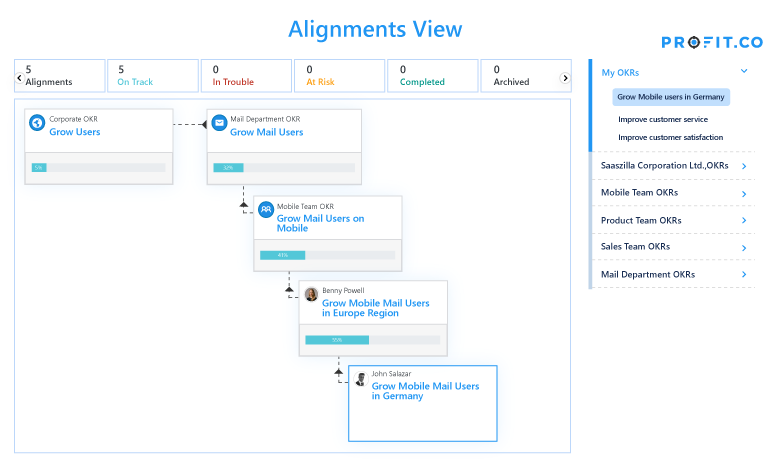
And then the KR for increasing new leads from zero to 30 could be given to the digital marketing team or the online marketing team, which is part of the marketing department. So, the point being, you can basically have company-wide or corporate OKRs, and then department OKRs and then be done with it.
Team-Level OKRs (Cross-Functional Team)
Now, there are other situations where you could say, “Okay, we actually need a team of people from different departments to execute this key result.” This scenario requires expertise from across the company, so you might choose to form a cross-functional team and assign them an OKR.
For example, an OKR to “Strengthen Our Sales Team” is necessarily going to be a cross-functional effort. While it will be the duty of the Sales department to revamp their Sales processes and strengthen their strategies, it will fall on other departments to support this effort. The Human Resources department should be tasked with training current talent to upskill the sales team, while customer service representatives should be assigned the responsibility of checking in with newly-onboarded clients frequently to avoid churn and ensure that the sales team is performing to the best of their ability.
Since there are so many different contributors to this OKR, it would be best for the organization to create a cross-functional team that puts all the right people responsible for different components of this OKR in one group. This helps maintain clarity and transparency in the organization and makes it crystal clear who is responsible for what.
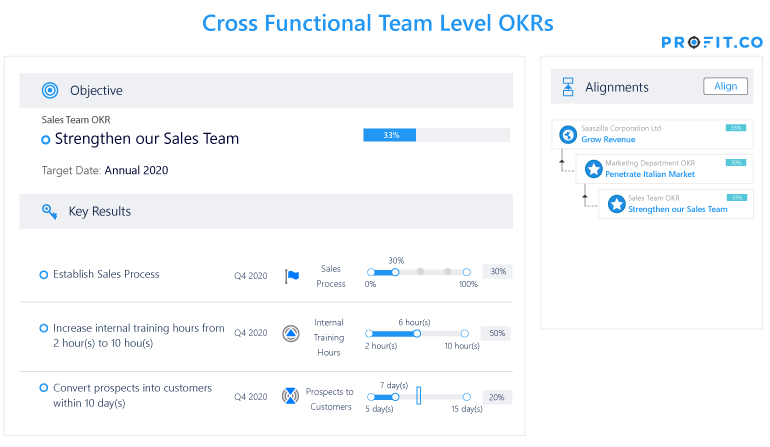
Individual OKRs
The final level organizations can set OKRs at is the individual OKR level. Employees can have their own OKRs, which essentially are actions that derive from the department level or team level OKRs, down to the individual level.
Let’s return to our original example to help understand Individual OKRs. The department key result “acquire 30 new leads from the Italian region,” Could become an objective for the digital marketing head. He could say, “Okay, I need to get 30 new leads from the Italian market in this quarter, so what do I do?” In response, he runs ads in certain places, let’s say, Google ads or LinkedIn ads or newspaper ads or magazine ads. Additionally, he might get PR involved to announce the company is entering new territory and do some press coverage and other things to get the message out which all results in awareness.
So basically, once awareness increases, people start taking notice of who you are and that you’re there. And then have a good, nice website to capture more traffic and then capture more interest. And that’s how you can go from zero to 30 leads. It could be the head of marketing’s OKR, or it could technically be a list of tasks that they go through and not necessarily tracking OKR. But it is possible to have company-wide OKRs, and then department OKRs, and then individual OKRs which lineup to either department or team OKRs. And basically all the four levels of OKRs co-exist in a particular OKR situation in the company.
Now, What is the Best Practice?
So you know the four OKR levels and your options for setting OKRs. The question remains: what is the best practice?
This question gets the most universal answer in management: it depends. Obviously, the maturity level of OKRs in your organization will be a big factor in deciding which levels you want to set OKRs at, as will the goals you’re setting and the size of your organization.
Rather than telling you what you should do for your organization (since OKRs are not one-size fits all!) let’s discuss your different options and approaches for rolling out your OKRs!
Most businesses use 2 or 3 levels to set OKRs. Corporate OKRs are almost always there. Other levels are included or excluded based on the strategy. So, using a combination of these four levels of OKRs, you can actually decide to launch your OKR program in five different approaches:
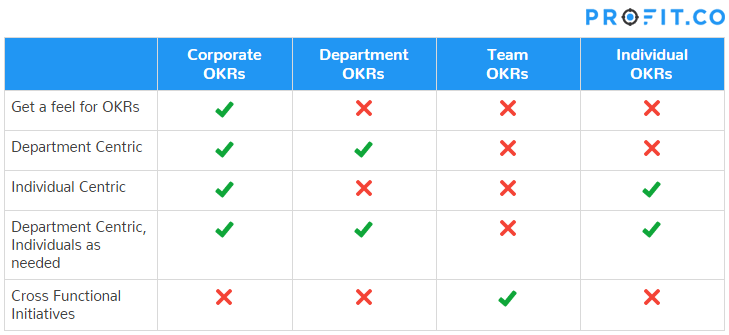
You can start with one and work your way to your Desired Position
The beauty of OKRs is that you have the option to stay agile. There’s no rule saying you have to pick one of these five approaches and stick with it– you can change from one approach to another approach as you progress through your OKR program or even completely change if needed.
An OKR software such as the Profit.co OKR management tool provides the flexible features you need to manage your goals with agility. You can get started on Profit.co completely free today!
So, the product offers that flexibility, but it’s also important to put in the right amount of effort into choosing the right approach for your goals to begin with, so you don’t end up wasting a lot of time going back and forth and figuring things out when you’re in production.
Thinking ahead will help you establish a Roadmap for your OKR Journey
A lot of thought needs to go in at the beginning to understand the benefits and shortcomings of each of these approaches and how it would actually suit your business. It’s important to think ahead, understand the different options here and establish a roadmap for your OKR journey, which again can be fine-tuned as you go, but having that roadmap clearly in your head is really important. So, the five options that we have here are:
- Get a feel for OKRs
- Department centric
- Individual centric
- Department centric, but individuals as needed
- Cross functional initiatives.
Let’s take a look at each of these approaches and what they’ll look like in practice.
Get a feel for OKRs
This can also be called real basic corporate OKRs. It’s called “get a feel for OKRs” for a reason– it’s the simplest way to roll out your OKRs. So, you only enable corporate OKRs in this case. Department OKRs, team OKRs and individual OKRs are turned off. We’ve seen small companies take this approach.
Basically, less than 15 to 20 employee companies and others who are at the beginning of their OKR journey choose this approach. They sometimes even go beyond the recommended number of five OKRs per level and add seven or eight OKRs, but keep all of them at the corporate level and then have key results underneath them assigned to individuals who are functioning in the company.
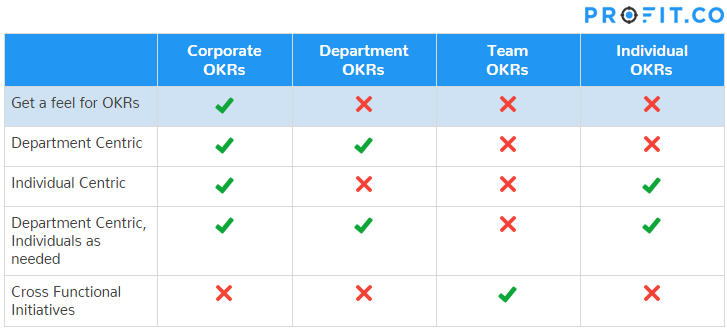
Can be a Great First Step
This approach is really simple and easy for everyone to understand. Also, there’s another advantage where, when you start implementing a new system or methodology, keeping the number of levels at which you do things to a minimum is very helpful. So, it can be a great first step in that sense.
Commitment to the Methodology is real clear to all Employees
Another benefit is that it is obvious that the company is committing to OKRs. When you’re starting, you could’ve said, “Hey, department A, can you go and try OKRs for a quarter and report back.” While you could really do that, if you start with this approach and say, “Hey, I’m starting at the corporate and I’m going to commit myself as the CEO or chief of strategy”, it sends a totally different message to all the employees. Again, it’s really simple, easy to get going, and demonstrates commitment.
Department Centric OKRs
Now, the second approach is department centric approach. Usually, you have corporate OKRs here as well, but in general you have OKRs defined at the department level. So, the approach or the underlying theme here is that we are going to have OKRs at the department or function level and not really going to have objectives cascading down to individual employees.
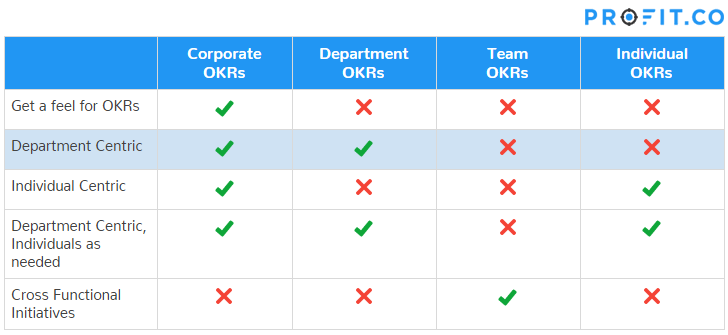
Create a Hierarchy of Departments as needed
Many times, you actually have a hierarchy of departments. So, you could actually have a marketing department at the top and then you could have an inbound marketing department, which could be everything related to bringing leads into your business. Under inbound you could have a search marketing subdepartment, a content subdepartment and then you could have a social media department and you could have many of those departments which would be sub functions of those.
Depending on the business, you could actually create deeper department hierarchies and then associate OKRs at that level.
You can assign Key Results to an Individual
Although the OKRs are at the department level, you still may want to assign key results to individuals. And that’s perfectly okay in this approach. It’s just that they are not going to take the key result and expand that into their own objective and key results. That’s the only difference. But key results can be assigned to individuals. This is actually a really, really good approach and there are many large companies that follow this in the tech world.
Settle the Performance Management Debate
This approach highlights the difference between OKRs and traditional HR performance management system. Because you’re not really asking individuals, “What did you accomplish or what did you not?” Here it’s collectively seen as a department level objective and key results related to the department and all the individuals are pulling it through and contributing. There’s a clear line of separation here. My individual employee level performance and development, et cetera is private and I keep it in the HR process, but then this is more of a business centric functional objectives which are important for the team that I’m also part of and contributing and tracking in being successful. So, that way this is very, very, very good from an approach standpoint.
Individual Centric OKRs
The third approach is what we call the individual centric OKRs. It’s pretty clear. OKRs here follow the management reporting hierarchy. So, the CEO has six different people reporting to him, including, for example, the chief marketing officer.
Some of the CEO’s OKRs will become the next level objectives for the CMO and some of the CMO’s key results will become next level objectives for the director of digital marketing and so on and so forth. So, basically there’s that cascading of responsibility according to the management reporting hierarchy.
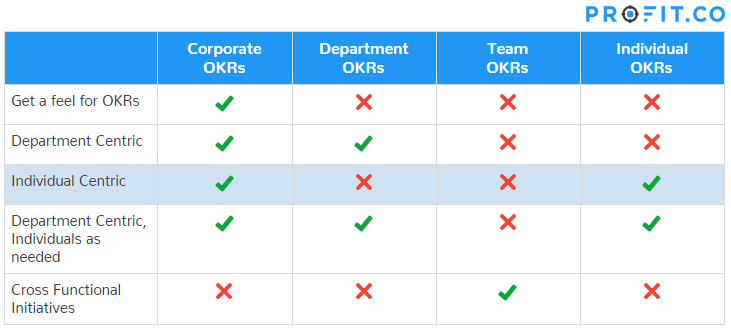
Lot more clarity around Who Owns What
There is certainly a lot more clarity in terms of who owns what. When it is at the department level, certainly the objectives and key results are owned by the department manager or the department head and key results themselves are assigned to individuals, but here there is no ambiguity. So, if my name is on my OKRs and everybody’s name is on their own OKRs and there’s no confusion around who is supposed to do what, or who dropped the ball if a target was missed. Everything is right there and clear.
Slightly Challenging to Manage Employee Role Changes and Turnover
It is a little bit of a challenge to manage when employees leave their roles or new employees come in with this approach. This is one of those reasons many of our clients have actually chosen the department centric approach rather than the individual approach.
Department OKRs + Individual OKRs
This approach combines department OKRs and individual OKRs. Now, this approach is basically department centric and individual as needed kind of an approach. It’s very similar to department OKRs, which is a really good approach by itself. But, sometimes they assign a key result to an individual from a department but there are still situations in which they have to expand that key result further down. Basically take that key result as an objective for themselves and expand that objective rather into a few key results at their individual level and then track and execute on that.
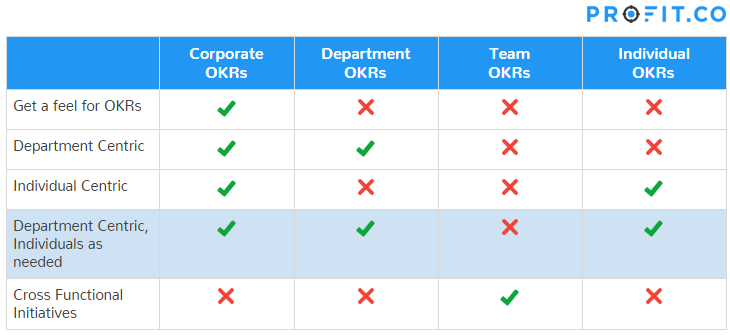
If adopted, one of the levels should be used as needed.
So, there is some benefit to it, but in general, it’s a lot simpler if you just choose to have one of the two levels. Either a department level or an individual level. If you do take this, you should have clear guidelines as to what is the norm for your specific organization, either department centric or individual centric.
Then, you should use the other very, very sparingly as you need it. There should be clear guidelines on when you would use them because when it comes to the review process and everything else, it’s a lot more challenging if you say, “Hey, that is at the department level, this is at the individual level.” And if you keep going around back and forth, it’s a lot more difficult to track, report and manage. So, we normally recommend against this approach, but we do have clients who have gone this route. If you do end up going with this approach, just make sure that there’s a very clear guideline on which level will be the default for your organization, and use the other one in certain circumstances.
Cross Functional OKRs
And the last one is really not a separate approach from the other four, it’s more of a combination. This approach is called cross functional OKRs.
We have had situations where for example, a new product needs to be launched on a war footing basis. A competitor might launch an incredible product and we get a corporate mandate that we have to give a strong response back. And in that case, we have seen clients create a cross functional team formed specifically to achieve that purpose. Based on the special need of your company, you form that team and you say, “Okay, so we will now have six months, leave everything and focus on creating a new product in response to the competition.” So, the competitor launched product X and then now you would like to get your product Y ready as a response to product X in the market.
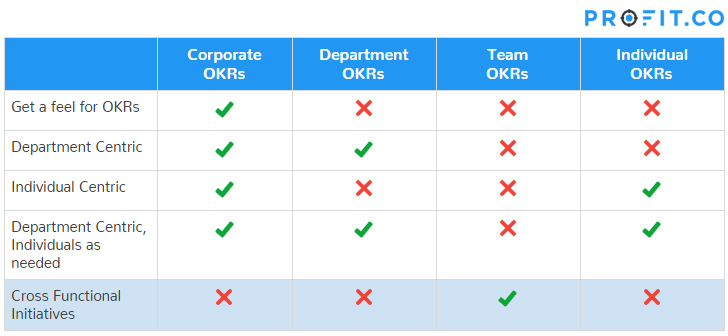
Generally you create cross functional teams to solve a specific problem
Now, you may have marketing folks, you may have engineering folks, you may have operations folks, you may have service folks and other department members involved in this response. So, you just create a cross functional team borrowing people from different departments. In general the management hierarchy doesn’t change, but they’re just loaned to this project for a certain timeframe. You go and solve this problem and once it’s resolved, you go back to your own departments. So, that’s the use of cross functional OKRs. Again, if you need it, you can use it, if you don’t, it’s okay, you don’t really need to use this.
Conclusion
So, those are the approaches for OKRs that we have in terms of getting your OKR program launched. You can certainly come back and change your direction and make some adjustments sometimes, especially once you go through a quarter or two, if you think that a different approach might be better, you can start the new quarter with a different approach. It’s definitely possible.
Remember that it’s not necessary to be rigid in this process. Be open to change and be flexible so that your team can find the OKR approach that works best for you. Now that you have an understanding of these four OKR levels and know the different approaches you can utilize to set OKRs in your organization, start experimenting in your organization and figure out what works best for you!
To learn more about how selecting the right level can impact your OKR program and how Profit.co can streamline your success, book a free demo with our OKR experts!
